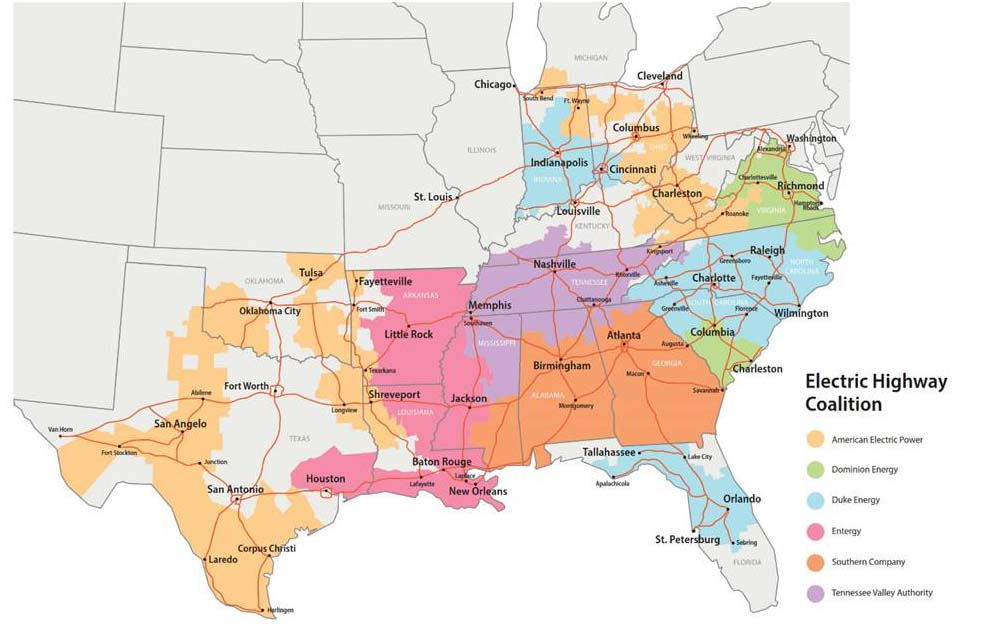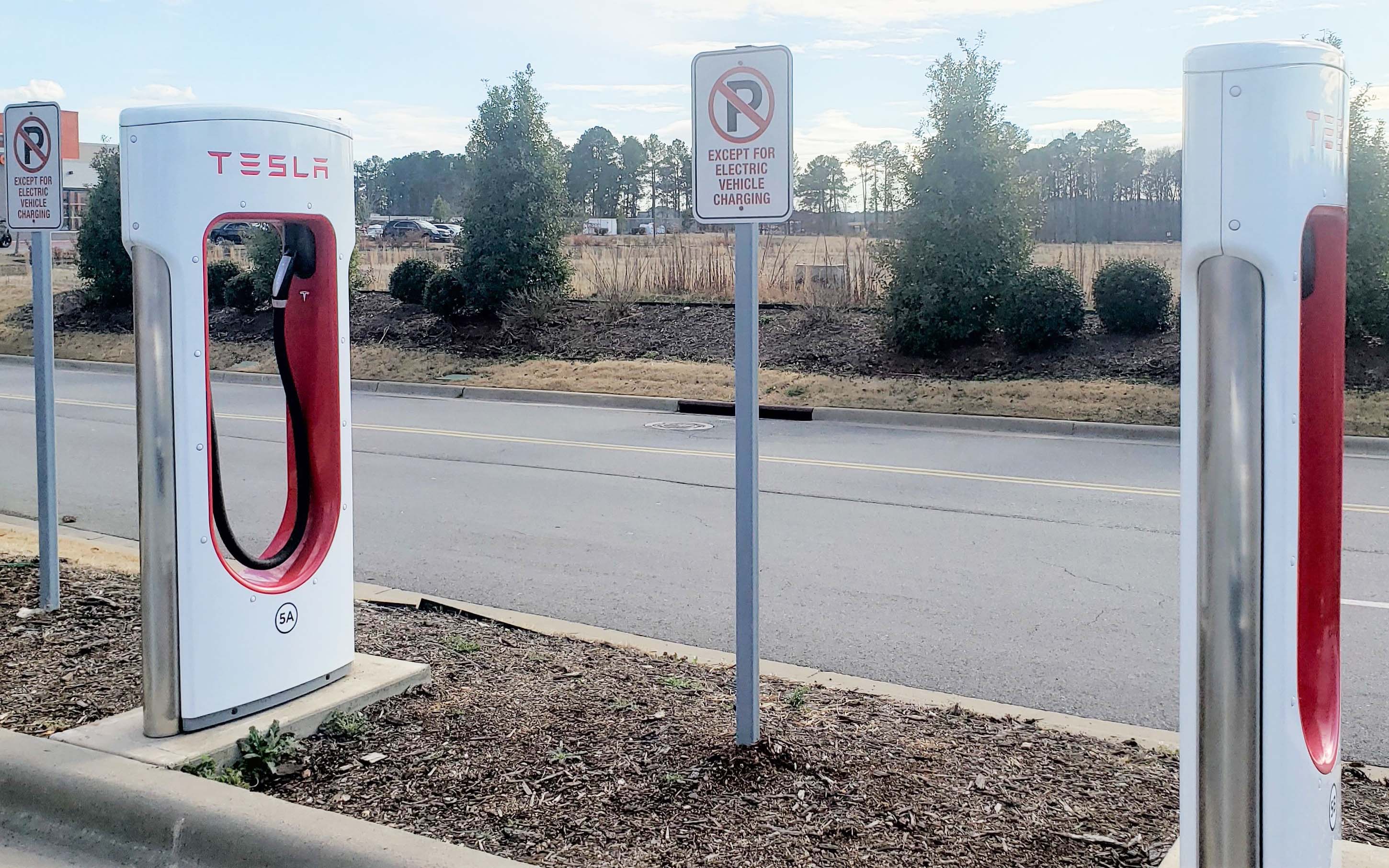Entergy joins multistate coalition to provide charging station network for electric cars
March 8-14, 2021
By Daily Record Staff
Entergy Corp., the parent company of Entergy Arkansas, is joining with five other top U.S. utilities to provide a network of charging stations for electric automobiles that stretch from west Texas eastward to Cleveland, Ohio and the Washington, D.C. area.
The Electric Highway Coalition – made up of Entergy, American Electric Power, Dominion Energy, Duke Energy, Southern Company, and the Tennessee Valley Authority – announced plans on March 2 to enable electric vehicle drivers seamless travel across major regions of the country through a network of direct current fast chargers for electric vehicles (EV). The companies are each taking steps to provide EV charging solutions within their service territories.
The utility coalition, which would connect major highway systems from the Atlantic Coast through the Midwest and South, and into the Gulf Coast and Central Plains regions, said the electric charging station network represents an unprecedented effort to offer EV drivers convenient charging options across different company service territories and allow EV travel without interruption.
“At Entergy, we are taking an integrated approach toward a carbon-free future that includes working with industry peers and customers to electrify other sectors of the economy like transportation and the maritime industry,” said Entergy Chairman and CEO Leo Denault. “Initiatives like this proposed regional EV charging corridor will help lower transportation emissions and provide community benefits for all our stakeholders.”
According to the Edison Electric Institute, there will be an estimated 18 million EVs will be on U.S. roads by 2030. While many drivers recognize the benefits of driving an EV, such as the ease of low-cost home charging, some are concerned with the availability of charging stations during long road trips. With efforts like the Electric Highway Coalition, electric companies are demonstrating to customers that EVs are a smart choice for driving around town as well as traveling long distances.
Entergy said the utility coalition will provide drivers with effective, efficient and convenient charging options that enable long distance electric travel. Sites along major highway routes with easy highway access and amenities for travelers are being considered as coalition members work to determine final charging station locations. Charging stations will provide DC fast chargers that can get drivers back on the road in approximately 20 to 30 minutes.
The Electric Highway Coalition, which includes six of the nation’s largest utility operators, said it welcomes other interested utilities to join as it seeks to extend the reach of network. Additionally, it supports and looks forward to working with other regional utility transportation corridor electrification initiatives.
Through the company’s Green Fleet Strategy, Entergy said it has sought to reduce the environmental impact of the company’s vehicles and equipment by using more efficient options, with a goal of achieving a 20% reduction in greenhouse gas emissions and fuel consumption from 2008 levels by 2020. Entergy achieved its target in 2015, five years ahead of schedule.
This strategy encompassed more efficient replacement practices, which reduced end-of-life costly repairs, purchasing more fuel-efficient engines, acquiring new emission system, and other drive train technology, which led to safe and less costly operations to the benefits of our employees and customers.
To further execute its strategy, Entergy said it has recently invested in more than 40 strategically located charging stations to be used by its growing electric vehicle fleet, which allows for nearly 90 vehicles to charge simultaneously. As further evidence of Entergy’s commitment to decarbonization, starting in 2023, Entergy’s fleet plan is for all passenger vehicles, fork-lifts, pallet jacks, etc., will be all-electric where readily available from the manufacturer. Also, 80% of the company’s aerial units will be powered by electricity by 2031.
Entergy has also actively monitored the latest technologies and market trends related to electric vehicles and continues to do so in preparation of engaging regulators to determine the best path forward on behalf of its customers, company officials said.
Climate change impact
Under Denault’s leadership, Entergy in April 2019 announced an ambitious new strategy to lower the company’s carbon footprint by 50% by 2030 and assume a leadership role in the development of cleaner fuel choices. In late September, the New Orleans-based utility accelerated those to achieve net-zero carbon emissions by 2050 and reaffirmed its commitment to improve grid reliability and affordability for customers.
Entergy Arkansas has also ramped up efforts to grow its renewable energy portfolio, announcing plans in August to purchase a 900-acre, 100-megawatt solar farm near Brinkley. Pending approval by the Arkansas Public Service Commission, Walnut Bend Solar in Lee County will be among the largest solar generating facilities in the state. The sun-powered facility will be designed and built by privately held Invenergy Renewables LLC, and then purchased by Entergy Arkansas after completion. Invenergy, based in Chicago, has developed 158 projects across the globe that generate 24,500 megawatts of power.
According to Entergy Arkansas officials, Walnut Bend will provide approximately 200 jobs during the construction phase, then 2-3 full-time employees once operational. The facility will generate an estimated $700,000 in annual property taxes for Lee County. Construction is scheduled to begin in the fourth quarter of 2021, and Walnut Bend Solar should be providing power to Entergy Arkansas customers by the end of 2022.
Walnut Bend will be the fourth Entergy Arkansas solar resource generating renewable, emission-free solar power for Entergy Arkansas’ customers. The other resources include 81-megawatt Stuttgart Solar, in operation since 2017; 100-megawatt Chicot Solar at Lake Village, which will go online this fall; and a 100-megawatt Searcy Solar facility, which is currently under development and will be completed in 2021 and purchased by Entergy Arkansas after its construction.
Besides Entergy, Columbus, Ohio-based AEP said it is committed to replacing its 2,300 cars and light-duty trucks with EV models by 2030. Additional medium- and heavy-duty vehicles will transition to hybrid or electric alternatives as models become available. Company officials said the charging network will enable AEP employees to use EVs to travel throughout the company’s 11-state service territory. AEP also is working with select customers across its service territory to help them understand the benefits of electrifying their own vehicle fleets or business processes.
“Throughout the ages, travelers have had to figure out how to get from point A to B. From feeding and watering horses, to filling gas tanks, and now recharging batteries, ensuring that there are convenient places to accomplish these tasks is critical,” said Nicholas Akins, AEP’s chairman, president and CEO. “With this effort, we are working to help drivers see that EVs fit their lifestyle and their travel plans, wherever the road might take them.”
Across its multistate service territory, which includes Southwestern Electric Power Co. in Arkansas, Texas and Louisiana and Public Service Company of Oklahoma, AEP said it is working with regulators to create programs that benefit all customers and support EV adoption, such as off-peak charging programs, incentives for charging station installations, energy efficiency rebates, and consultative services to encourage electrification.
In 2018, AEP Ohio launched a $10 million program to deploy 375 charging stations in partnership with local governments, workplaces and multi-family dwellings to increase publicly available charging sites and demonstrate the benefit of public-private partnerships as part of the Smart Columbus initiative. The program included a requirement to locate 10% of the charging stations in low-income areas, a benchmark that was exceeded.
MAP CAPTION:
The Electric Highway Coalition connects major highway systems from the Atlantic Coast through the Midwest and South, and into the Gulf Coast and Central Plains regions. Besides Entergy, the group includes American Electric Power, Dominion Energy, Duke Energy, Southern Company, and the Tennessee Valley Authority.




